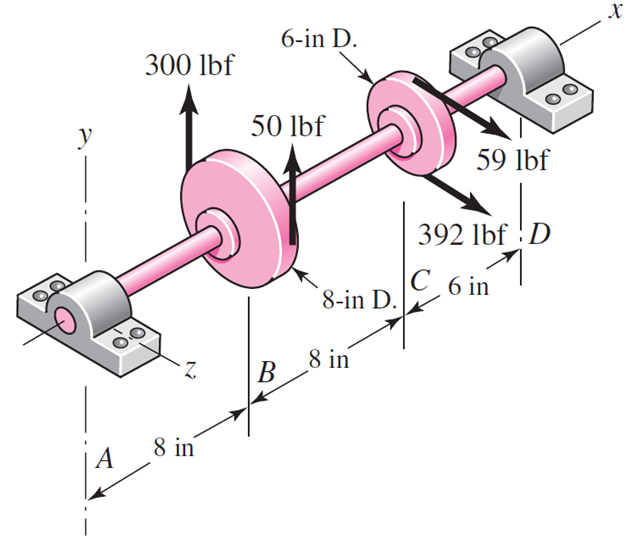Disclaimer
Images for Problems are taken from Shigley’s (9th edition).
Problem 1 (10 Points)
A ductile hot-rolled steel bar has a minimum yield strength in tension and compression of 350 MPa. Using the distortion-energy and maximum-shear-stress theories determine the factors of safety for the following principal stresses:
- $\sigma_A = 100 MPa$, $\sigma_B = 100 MPa$
- $\sigma_A = 100 MPa$, $\sigma_B = -100 MPa$
- $\sigma_A = -50 MPa$, $\sigma_B = -100 MPa$
Problem 2 (10 Points)
A ductile material has the properties $S_{yt}=60ksi$, $S_{yc}=75ksi$ Using the ductile Coulomb-Mohr theory, determine the factor of safety for the states of stress given below:
- $\sigma_x = 25 kpsi$, $\sigma_y = 15 kpsi$
- $\sigma_x = -12 kpsi$, $\sigma_y = 15 kpsi$, $\tau_{xy} = -9 kpsi$
Problem 3 (10 Points)
A brittle material has the properties $S_{ut} = 30 kpsi$, $S_{uc} = 90 kpsi$. Using the brittle Coulomb-Mohr and modified-Mohr theories, determine the factor of safety for the following states of plane stress.
- $\sigma_x = -15 kpsi$, $\sigma_y = 10 kpsi$, $\tau_{xy} = -15 kpsi$
- $\sigma_x = 15 kpsi$, $\sigma_y = -15 kpsi$
Problem 4 (20 Points)
Determine the actual factor of safety for yielding for problem 2 from HW1. Use the distortion-energy theory. The material is 1018 CD steel.
Problem 5 (30 Points)
The figure shows a shaft mounted in bearings at A and D and having pulleys at B and C. The forces shown acting on the pulley surfaces represent the belt tensions. The shaft is to be made of AISI 1035 CD steel. Using distortion-energy theory with a design factor of 2, determine the minimum shaft diameter to avoid yielding.

Problem 6 (30 Points)
Prepare the following materials for your team presentation.
- (15 Points) A presentation that covers key concepts for others to understand the workflow of your analysis and design code.
-
For Shaft teams: The presentation should cover (1) an overview of the shaft design process, i.e., the determination of shaft dimensions based on its connected components and design requirements (e.g., safety factors for fatigue, yielding, and deflection failure modes), (2) a summary of critical points on a shaft, and (3) an introduction to your code with a sample use case.
-
For Gear and Key/Bearing teams: The presentation should cover (1) an introduction to spur gear (nomenclature, key parameters and their relationships, geometric constraints, force analysis), (2) an overview of the gear design process, i.e., the determination of gear ratio, geometric parameters, and gear materials based on design requirements (e.g., safety factors for wear and yielding failure modes), (3) an introduction to your code with a sample use case, (4) an introduction to key and bearing (nomenclature, parameters, and existing catalog), (5) an overview of the key and the bearing design process, and (6) an introduction to your code with sample use cases.
-
- (15 Points) A repo on GitHub (or other opensource platforms) that contains the following:
- A main code that executes the component-wise analysis and design functions.
- A readme file that explains the expected inputs and outputs of the code.
- The code can be written in any language of your choice.